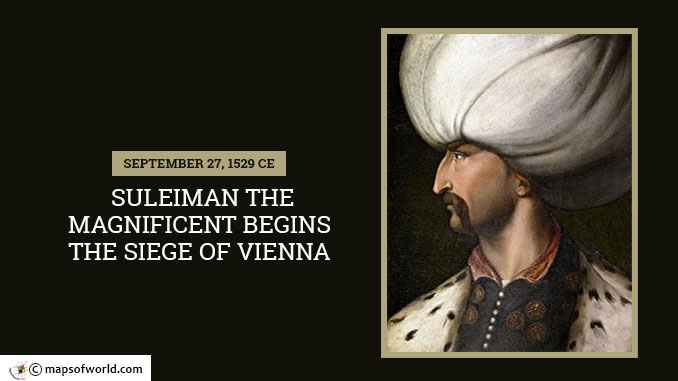In the 75 years since the Ottomans captured Constantinople, the Turks engaged in a methodical advance westward into Europe. On September 27, 1529, that policy of encroachment came to its head: Suleiman I posted his armies around the Austrian capital of Vienna — the Ottoman Empire was now threatening the very heart of the continent. Though unsuccessful at first, the attack signalled the start of more than 150 years of conflict between the Europeans and Ottomans. The first inkling of a new, aggressive empire emanating from the Middle East came in 1453, when Mehmed II led his armies into Constantinople after bombarding the thick fortifications for weeks with European cannons. In killing the Byzantine Emperor Constantine XI Palaiologos, the Muslim conquerors had struck a blow to Christianity and could now move further into Europe without the threat of attack from Asia Minor. Without the need to be concerned with the possibility of usurpers rising up from the east, Ottoman leaders pushed further west, with Sultan Suleiman I annihilating the Hungarian armies at Mohacs in 1526. Half of King Louis II of Hungary’s territory — Transylvania and other states — now claimed allegiance to the Ottomans, with the rest submitting to the rule of the Habsburg family in Austria. Intent on cementing his control of Hungary and expanding the empire ever further, Suleiman soon set his sights 200 miles to the northwest of his great triumph at Mohacs: Vienna, the seat of the Habsburg royal family. Gathering soldiers from conquered territories in modern Bulgaria, Serbia and Ukraine to combine with his troops from Turkey, Suleiman began the march toward Vienna in mid-August. With an estimated size of 120,000 men, the Ottoman force lumbered through the heavy forests along the Danube River facing unforgiving conditions — rains heavier than normal turned much of the trail into a muddy mess. Illness and death were rampant, not to mention extensive loss of equipment as the heavy artillery sank too deep in the mire to be recovered. Those who arrived outside the Austrian capital were weary and hungry, hardly capable of launching a full-scale attack. In Vienna, troops and volunteers had been working to fortify the city for weeks. Buttressed by a few thousand German mercenaries and Spanish musketeers, the Austrians had some 23,000 men available to protect the capital. Facing a numerically superior force, defenders went to work disrupting Ottoman preparations by taking calculated risks to root out mines and tunnels, often successfully destroying them before any damage could be done to the strong walls surrounding the city with few casualties. Suleiman could not count himself so lucky. Though his artillery had begun pounding Vienna from nearly the moment they arrived on September 27, 1529, very little progress had been made. The strength of the Austrian preparations left the sultan facing unrest as the siege moved from several days to two weeks. With illness continuing to ravage his army, not to mention a continuation of the water-logged conditions his soldiers faced on the march to Vienna, a decision had to be made. Bringing his generals together on October 12th, Suleiman came to the conclusion his rain-soaked men could only be asked to make one last attempt to break through. Beaten back once again, the Ottomans turned toward Hungary to cut their losses. Facing worsening conditions on the trip back — including deep snows — more of Suleiman’s men and equipment were lost. It would be another three years before he could muster an army to attack Vienna again. Also On This Day:1540 – The Jesuits receive a charter from Pope Paul III 1825 – The world’s first passenger train service, the Stockton and Darlington Railway, begins operations 1905 – Albert Einstein’s infamous equation E=mc² is published in Annalen der Physik 1928 – The Republic of China is recognized by the United States 1956 – United States Air Force Captain Milburn Apt achieves a speed of Mach 3 in the Bell X-2, dying shortly afterward as aircraft spins out of control.
September 27 1529 CE – Suleiman the Magnificent Begins the Siege of Vienna
In the 75 years since the Ottomans captured Constantinople, the Turks engaged in a methodical advance westward into Europe. On September 27, 1529, that policy of encroachment came to its…
726
